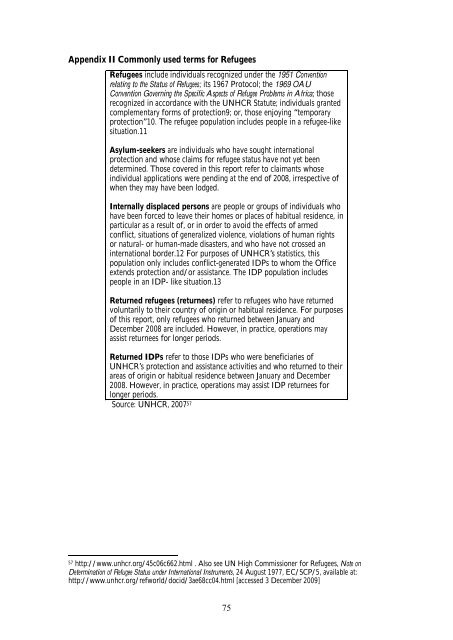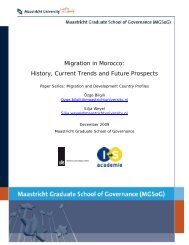Migration in Burundi: History, Current Trends and Future - MGSoG ...
Migration in Burundi: History, Current Trends and Future - MGSoG ...
Migration in Burundi: History, Current Trends and Future - MGSoG ...
Create successful ePaper yourself
Turn your PDF publications into a flip-book with our unique Google optimized e-Paper software.
Appendix II Commonly used terms for Refugees<br />
Refugees <strong>in</strong>clude <strong>in</strong>dividuals recognized under the 1951 Convention<br />
relat<strong>in</strong>g to the Status of Refugees; its 1967 Protocol; the 1969 OAU<br />
Convention Govern<strong>in</strong>g the Specific Aspects of Refugee Problems <strong>in</strong> Africa; those<br />
recognized <strong>in</strong> accordance with the UNHCR Statute; <strong>in</strong>dividuals granted<br />
complementary forms of protection9; or, those enjoy<strong>in</strong>g “temporary<br />
protection”10. The refugee population <strong>in</strong>cludes people <strong>in</strong> a refugee-like<br />
situation.11<br />
Asylum-seekers are <strong>in</strong>dividuals who have sought <strong>in</strong>ternational<br />
protection <strong>and</strong> whose claims for refugee status have not yet been<br />
determ<strong>in</strong>ed. Those covered <strong>in</strong> this report refer to claimants whose<br />
<strong>in</strong>dividual applications were pend<strong>in</strong>g at the end of 2008, irrespective of<br />
when they may have been lodged.<br />
Internally displaced persons are people or groups of <strong>in</strong>dividuals who<br />
have been forced to leave their homes or places of habitual residence, <strong>in</strong><br />
particular as a result of, or <strong>in</strong> order to avoid the effects of armed<br />
conflict, situations of generalized violence, violations of human rights<br />
or natural- or human-made disasters, <strong>and</strong> who have not crossed an<br />
<strong>in</strong>ternational border.12 For purposes of UNHCR’s statistics, this<br />
population only <strong>in</strong>cludes conflict-generated IDPs to whom the Office<br />
extends protection <strong>and</strong>/or assistance. The IDP population <strong>in</strong>cludes<br />
people <strong>in</strong> an IDP- like situation.13<br />
Returned refugees (returnees) refer to refugees who have returned<br />
voluntarily to their country of orig<strong>in</strong> or habitual residence. For purposes<br />
of this report, only refugees who returned between January <strong>and</strong><br />
December 2008 are <strong>in</strong>cluded. However, <strong>in</strong> practice, operations may<br />
assist returnees for longer periods.<br />
Returned IDPs refer to those IDPs who were beneficiaries of<br />
UNHCR’s protection <strong>and</strong> assistance activities <strong>and</strong> who returned to their<br />
areas of orig<strong>in</strong> or habitual residence between January <strong>and</strong> December<br />
2008. However, <strong>in</strong> practice, operations may assist IDP returnees for<br />
longer periods.<br />
Source: UNHCR, 2007 57<br />
57 http://www.unhcr.org/45c06c662.html . Also see UN High Commissioner for Refugees, Note on<br />
Determ<strong>in</strong>ation of Refugee Status under International Instruments, 24 August 1977, EC/SCP/5, available at:<br />
http://www.unhcr.org/refworld/docid/3ae68cc04.html [accessed 3 December 2009]<br />
75



